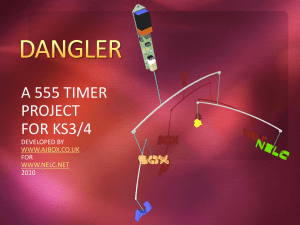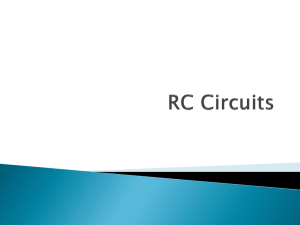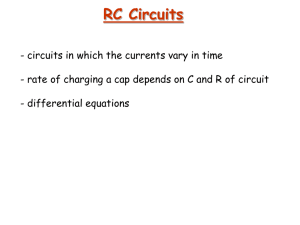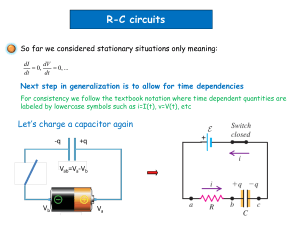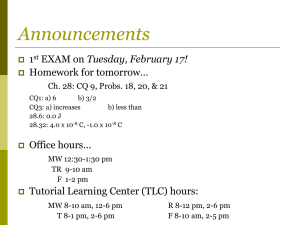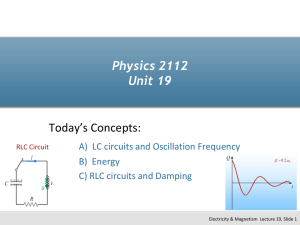RC-Circuits
advertisement
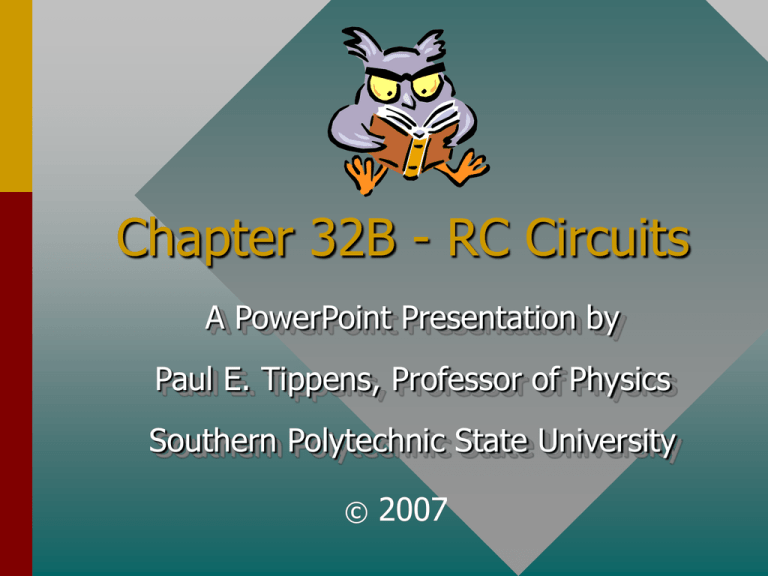
Chapter 32B - RC Circuits A PowerPoint Presentation by Paul E. Tippens, Professor of Physics Southern Polytechnic State University © 2007 RC Circuits: The rise and decay of currents in capacitive circuits Optional: Check with Instructor The calculus is used only for derivation of equations for predicting the rise and decay of charge on a capacitor in series with a single resistance. Applications are not calculus based. Check with your instructor to see if this module is required for your course. RC Circuit RC-Circuit: Resistance R and capacitance C in series with a source of emf V. a R a R - - C V b i + + + + V b - - q C C Start charging capacitor. . . loop rule gives: q E iR; V C iR RC Circuit: Charging Capacitor R a i + + V b - - q C C q V iR C dq q R V dt C Rearrange terms to place in differential form: Multiply by C dt : dq dt (CV q) RC RCdq (CV q)dt q t dt dq 0 (CV q) o RC RC Circuit: Charging Capacitor R a i + + V b - - q C C t dt dq 0 (CV q) o RC t q ln(CV q) 0 RC q t ln(CV q) ln(CV ) RC CV q CVe (1/ RC ) t (CV q) t ln CV RC q CV 1 e t / RC RC Circuit: Charging Capacitor R a i + + V b - - q C C Instantaneous charge q on a charging capacitor: q CV 1 e t / RC At time t = 0: q = CV(1 - 1); q = 0 At time t = : q = CV(1 - 0); qmax = CV The charge q rises from zero initially to its maximum value qmax = CV Example 1. What is the charge on a 4-mF capacitor charged by 12-V for a time t = RC? Qmax q a R = 1400 W Capacitor Rise in Charge t V b i + + 0.63 Q - - 4 mF Time, t The time t = RC is known as the time constant. q CV 1 e t / RC q CV 1 e 1 e = 2.718; e-1 = 0.63 q CV 1 0.37 q 0.63CV Example 1 (Cont.) What is the time constant t? Qmax q Rise in Charge t V b i + + 0.63 Q a R = 1400 W Capacitor - - 4 mF Time, t The time t = RC is known as the time constant. t = (1400 W)(4 mF) t = 5.60 ms In one time constant (5.60 ms in this example), the charge rises to 63% of its maximum value (CV). RC Circuit: Decay of Current R a i + + V b - - q C C As charge q rises, the current i will decay. q CV 1 e t / RC dq d CV t / RC t / RC i CV CVe e dt dt RC Current decay as a capacitor is charged: V t / RC i e R Current Decay R a i + + V b - - q C C I i Capacitor Current Decay 0.37 I t Time, t Consider i when t = 0 and t = . The current is a maximum of I = V/R when t = 0. V t / RC i e R The current is zero when t = (because the back emf from C is equal to V). Example 2. What is the current i after one time constant (t RC)? Given R and C as before. I i Capacitor 0.37 I t V b i + + Current Decay a R = 1400 W - - 4 mF Time, t The time t = RC is known as the time constant. V t / RC V 1 i e e R C e = 2.718; e-1 = 0.37 V i 0.37 0.37imax R Charge and Current During the Charging of a Capacitor. Qmax q 0.63 I Capacitor Rise in Charge t Time, t I i Capacitor Current Decay 0.37 I t Time, t In a time t of one time constant, the charge q rises to 63% of its maximum, while the current i decays to 37% of its maximum value. RC Circuit: Discharge After C is fully charged, we turn switch to b, allowing it to discharge. a R a R - - C V b i + + + + V b - - q C C Discharging capacitor. . . loop rule gives: E iR; Negative because q iR of decreasing I. C Discharging From q0 to q: R a i dq dt ; q RC + + V b q C - - C Instantaneous charge q on discharging capacitor: dq q RCi; q RC dt t dt dq q0 q 0 RC ; q t ln q ln q0 RC ln qq q 0 t t RC 0 q t ln q0 RC Discharging Capacitor R a i + + V b q C - - C q t ln q0 RC q q0e t / RC Note qo = CV and the instantaneous current is: dq/dt. dq d CV t / RC t / RC i CVe e dt dt RC V t / RC Current i for a i e discharging capacitor. C Prob. 45. How many time constants are needed for a capacitor to reach 99% of final charge? a R q i + + V b C q qmax 1 e C - - q qmax Let x = t/RC, then: 1 x 0.01; e 100 x e x = 4.61 t / RC 0.99 1 e t / RC e-x = 1-0.99 or e-x = 0.01 From definition of logarithm: t x RC ln e (100) x 4.61 time constants Prob. 46. Find time constant, qmax, and time to reach a charge of 16 mC if V = 12 V and C = 4 mF. a 1.4 MW V 12 V 1.8 mF i - -C t = RC = (1.4 MW)(1.8 mF) qmax = CV = (1.8 mF)(12 V); q qmax + + bR q qmax 1 e t / RC 16m C t / RC 1 e 21.6m C t = 2.52 s qmax = 21.6 mC 1 e Continued . . . t / RC 0.741 Prob. 46. Find time constant, qmax, and time to reach a charge of 16 mC if V = 12 V and C = 4 mF. a 1.4 MW V 12 V 1.8 mF i - -C 1 x 0.259; e 3.86 x e x = 1.35 0.741 Let x = t/RC, then: + + bR 1 e t / RC e x 1 0.741 0.259 From definition of logarithm: t 1.35; RC Time to reach 16 mC: lne (3.86) x t (1.35)(2.52s) t = 3.40 s CONCLUSION: Chapter 32B RC Circuits
![Sample_hold[1]](http://s2.studylib.net/store/data/005360237_1-66a09447be9ffd6ace4f3f67c2fef5c7-300x300.png)
